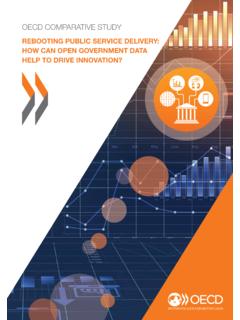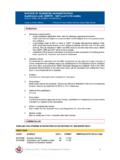Transcription of Ilija Radosavovic Piotr Dollar Ross Girshick Georgia ...
1 Data Distillation: Towards Omni-Supervised LearningIlija RadosavovicPiotr Doll arRoss GirshickGeorgia GkioxariKaiming HeFacebook AI Research (FAIR)AbstractWe investigateomni-supervised learning, a specialregime of semi-supervised learning in which the learner ex-ploits all available labeled data plus internet-scale sourcesof unlabeled learning is lower-bounded by performance on existing labeled datasets, of-fering the potential to surpass state-of-the-art fully super-vised methods. To exploit the omni-supervised setting, weproposedata distillation, a method that ensembles predic-tions from multiple transformations of unlabeled data, us-ing a single model, to automatically generate new trainingannotations. We argue that visual recognition models haverecently become accurate enough that it is now possible toapply classic ideas about self-training to challenging real-world data.
2 Our experimental results show that in the casesof human keypoint detection and general object detection,state-of-the-art models trained with data distillation sur-pass the performance of using labeled data from the COCO dataset IntroductionThis paper investigatesomni-supervised learning, aparadigm in which the learner exploits as much well-annotated data as possible ( , ImageNet [6], COCO [24])and is also provided with potentially unlimited unlabeleddata ( , from internet-scale sources). It is a special regimeof semi-supervised learning. However, most research onsemi-supervised learning hassimulatedlabeled/unlabeleddata by splitting a fully annotated dataset and is there-fore likely to beupper-boundedby fully supervised learn-ing with all annotations. On the contrary, omni-supervisedlearning islower-boundedby the accuracy of training onall annotated data, and its success can be evaluated by howmuch it surpasses the fully supervised tackle omni-supervised learning, we propose to per-form knowledge distillationfrom data, inspired by [3, 18]which performed knowledge distillationfrom models.
3 Ouridea is to generate annotations on unlabeled data using amodel trained on large amounts of labeled data, and thenretrain the model using the extra generated , training a model on its own predictions often pro-vides no meaningful information. We address this problemmodel Amodel Bmodel Cimageensemblestudent modelpredictModel Distillationstudent modelpredictensembleimagetransform Amodel Atransform Btransform CData Distillationmodel Amodel AFigure Distillation [18]vs. Data datadistillation, ensembled predictions from a single model applied tomultiple transformations of an unlabeled image are used as auto-matically annotated data for training a student ensembling the results of a single model run on differenttransformations ( , flipping and scaling) of an unlabeledimage. Such transformations are widely known to improvesingle-model accuracy [20] when applied at test time, indi-cating that they can provide nontrivial knowledge that is notcaptured by a single prediction.
4 In other words, in compar-ison with [18], which distills knowledge from the predic-tions of multiple models, we distill the knowledge of a sin-gle model run on multiple transformed copies of unlabeleddata (see Figure 1).Data distillation is a simple and natural approach basedon self-training ( , making predictions on unlabeleddata and using them to update the model), related to whichthere have been continuous efforts [36, 48, 43, 33, 22, 46,5, 21] dating back to the 1960s, if not earlier. However,our simple data distillation approach can become realisticlargely thanks to the rapid improvement of fully-supervisedmodels [20, 39, 41, 16, 12, 11, 30, 28, 25, 15] in the pastfew years. In particular, we are now equipped with accu-rate models that may make fewer errors than correct pre-dictions. This allows us to trust their predictions on unseen1 [ ] 12 Dec 2017data and reduces the requirement for developing data clean-ing heuristics.
5 As a result, data distillation does not requireone to change the underlying recognition model ( , nomodification on the loss definitions), and is a scalable solu-tion for processing large-scale unlabeled data test data distillation for omni-supervised learning, weevaluate it on the human keypoint detection task of theCOCO dataset [24]. We demonstrate promising signalson this real-world, large-scale application. Specifically, wetrain a Mask R-CNN model [15] using data distillation ap-plied on the original labeled COCO set and another largeunlabeled set ( , static frames from Sports-1M [19]). Us-ing the distilled annotations on the unlabeled set, we haveobserved improvement of accuracy on the held-out valida-tion , we show an up to 2 points AP improvementover the strong Mask R-CNN baseline. As a reference, thisimprovement compares favorably to the 3 points AP im-provement gained from training on a similar amount of extramanually labeleddata in [27] (using private annotations).
6 We further explore our method on COCO object detectionand show gains over fully-supervised Related WorkEnsembling [14] multiple models has been a successfulmethod for improving accuracy. Model compression [3] isproposed to improve test-time efficiency of ensembling bycompressing an ensemble of models into a single studentmodel. This method is extended in knowledge distillation[18], which uses soft predictions as the student s idea of distillation has been adopted in various sce-narios. FitNet [32] adopts a shallow and wide teacher mod-els to train a deep and thin student model. Cross modaldistillation [13] is proposed to address the problem of lim-ited labels in a certain modality. In [26] distillation is uni-fied with privileged information [44]. To avoid explicitlytraining multiple models, Laine and Aila [21] exploit mul-tiple checkpoints during training to generate the ensemblepredictions.
7 Following the success of these existing works,our approach distills knowledge from a lightweight ensem-ble formed by multiple data is a great volume of work on semi-supervisedlearning, and comprehensive surveys can be found in [49,4, 50]. Among semi-supervised methods, our method ismost related to self-training, a strategy in which a model spredictions on unlabeled data are used to train itself [36,48, 43, 33, 22, 46, 5, 21]. Closely related to our workon keypoint/object detection, Rosenberget al. [33] demon-strate that self-training can be used for training object detec-tors. Compared to prior efforts, our method is substantiallysimpler. Once the predicted annotations are generated, ourmethod leverages them as if they were true labels; it doesnot require any modifications to the optimization problemor model views or perturbations of the data can pro-vide useful signal for semi-supervised learning.
8 In the co-training framework [2], different views of the data are usedto learn two distinct classifiers that are then used to trainone another over unlabeled data. Reedet al. [29] use a re-construction consistency term for training classification anddetection models. Bachmanet al. [1] employ the pseudo-ensemble regularization term to train models robust on in-put perturbations. Sajjadiet al. [35] enforce consistencybetween outputs computed for different transformations ofinput examples. Simonet al. [38] utilize multi-view geom-etry to generate hand keypoint labels from multiple camerasand retrain the detector. In an auto-encoder scenario, Hintonet al. [17] propose to use multiple capsules to model mul-tiple geometric transformations. Our method is also basedon multiple geometric transformations, but it does not re-quire to modify network structures or impose consistencyby adding any extra loss the large-scale regime, Ferguset al.
9 [9] inves-tigate semi-supervised learning on 80 millions tiny Never Ending Image Learner (NEIL) [5] employs self-training to perform semi-supervised learning from web-scale image data. These methods were developed before therecent renaissance of deep learning. In contrast, our methodis evaluated with strong deep neural network baselines, andcan be applied to structured prediction problems beyondimage-level classification ( , keypoints and boxes).3. Data DistillationWe proposedata distillation, a general method for omni-supervised learning that distills knowledge from unlabeleddata without the requirement of training a large set of mod-els. Data distillation involves four steps: (1) training amodel on manually labeled data (just as in normal super-vised learning); (2) applying the trained model to multipletransformations of unlabeled data; (3) converting the pre-dictions on the unlabeled data into labels by ensembling themultiple predictions; and (4) retraining the model on theunion of the manually labeled data and automatically la-beled data.
10 We describe steps 2-4 in more detail common strategy for boost-ing the accuracy of a visual recognition model is to applythe same model to multiple transformations of the input andthen to aggregate the results. Examples of this strategy in-clude using multiple crops of an input image ( , [20, 42])or applying a detection model to multiple image scales andmerging the detections ( , [45, 8, 7, 37]). We refer tothe general application of inference to multiple transforma-tions of a data point with a single model asmulti-transforminference. In data distillation, we apply multi-transform in-ference to a potentially massive set of unlabeled Atransform Btransform CFigure keypoint predictions from multiple data transformations can yield a single superior (automatic) visualization purposes all images and keypoint predictions are transformed back to their original coordinate labels on unlabeled aggregating theresults of multi-transform inference, it is often possible toobtain a single prediction that is superior to any of themodel s predictions under a single transform ( , see Fig-ure 2).
![arXiv:0706.3639v1 [cs.AI] 25 Jun 2007](/cache/preview/4/1/3/9/3/1/4/b/thumb-4139314b93ef86b7b4c2d05ebcc88e46.jpg)

![arXiv:1301.3781v3 [cs.CL] 7 Sep 2013](/cache/preview/4/d/5/0/4/3/4/0/thumb-4d504340120163c0bdf3f4678d8d217f.jpg)
![@google.com arXiv:1609.03499v2 [cs.SD] 19 Sep 2016](/cache/preview/c/3/4/9/4/6/9/b/thumb-c349469b499107d21e221f2ac908f8b2.jpg)








